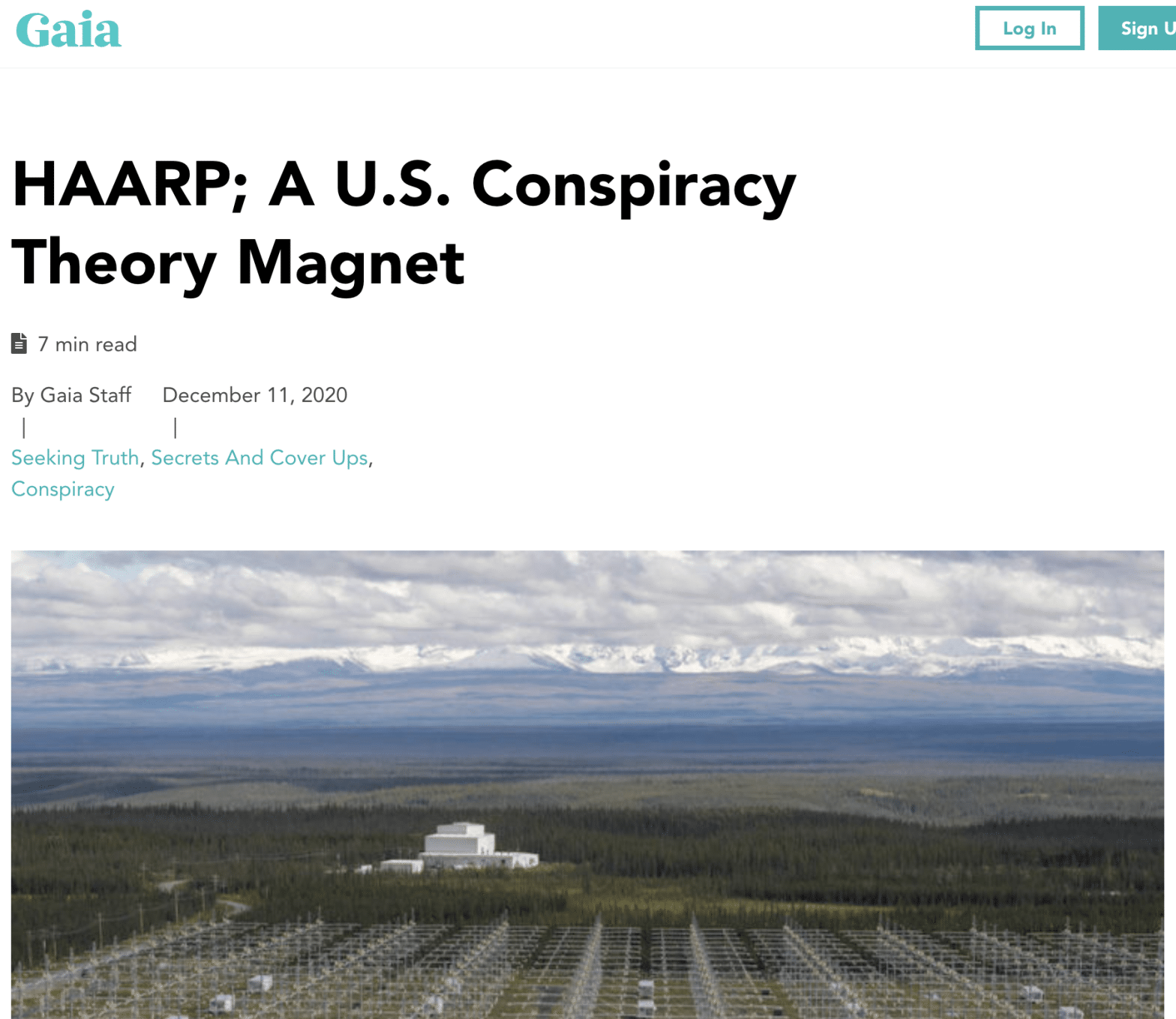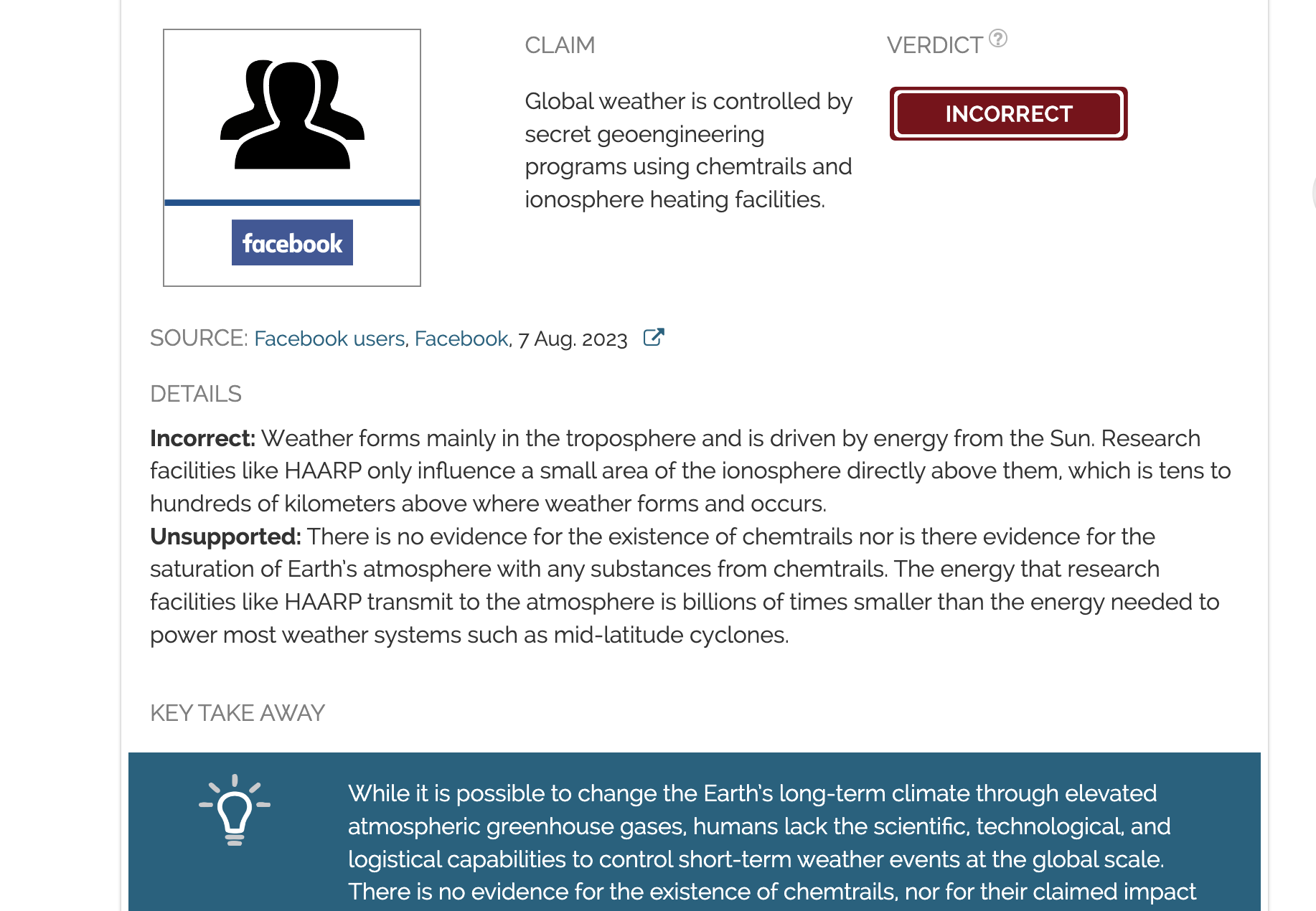- Climate
The scientific research facility HAARP cannot create natural disasters or influence human thoughts and movements, contrary to online claims
Key takeaway
The High-frequency Active Auroral Research Program (HAARP) is a research facility that uses a high-power, high-frequency transmitter to study the physical properties and behaviour of the highest point of the atmosphere, the ionosphere. One example of natural phenomena that HAARP studies is the aurora borealis, also known as the northern lights. Radio transmissions from HAARP only cause small effects in the ionosphere that last for a brief span of a few seconds. There is no evidence that HAARP can cause natural disasters or influence with human movements and thoughts.
Reviewed content

Verdict:
Verdict detail
Incorrect: The Gaia article leaves the reader with an extremely poor understanding of how the High-frequency Active Auroral Research Program (HAARP) works. The facility is a high-frequency (shortwave radio) transmitter and doesn’t transmit low-frequency vibrations, as stated in the Gaia article. HAARP analyzes physics phenomena in the uppermost part of the atmosphere (known as the ionosphere) by studying the small heating effects the transmitter creates there that last for only a few seconds. Thus, it cannot affect human thought processes or movements in any way.
Inadequate support: There is no scientific evidence provided to support the claims made in the Gaia article about HAARP’s ability to cause natural disasters or control human behaviors. The Gaia article cited an article by the U.K. tabloid The Express and another Gaia article as supporting evidence for the natural disasters claim, but these are not scientific or peer-reviewed sources. The claim that HAARP can control minds is purportedly supported by a “leaked classified government file”, but the article provided no direct link or reference to this file.
Full Claim
The HAARP organization may deliberately create destruction on a global scale, causing earthquakes, cyclones, flooding, snowstorms, and other disasters, around the world; The HAARP facility may be attacking the citizens of the world telepathically, influencing thoughts with low frequency vibrations; "it is possible to control human movements, glandular functions, and specific mental manifestations using electromagnetic stimulation."
Review
The claim appeared in an article published by Gaia in mid-December 2020, receiving more than 16,000 interactions on Facebook according to the social media analytics tool Crowdtangle. The High-frequency Active Auroral Research Program (HAARP) is a research facility operated by the University of Alaska Fairbanks[1]. It transmits high-frequency radio signals into the highest point of the atmosphere, the ionosphere, using 360 radio transmitters and 180 antennas. The facility covers about 14 hectares (0.14 kilometers squared) near the town of Gakona, Alaska, which is about 250 kilometers northeast of Anchorage, Alaska’s largest city. The radio signals are partially absorbed between 100 kilometers and 350 kilometers in altitude, accelerating electrons in the ionosphere and briefly “heating” it up[2]. By analyzing how radio waves interact with electrons in the ionosphere[3,4], researchers at HAARP are able to study phenomena, such as the effects of the aurora borealis, or northern lights, on radio systems and aircraft communications at high altitudes.
HAARP has previously been the subject of conspiracy theories, but “claims in the Gaia article about HAARP’s ability to cause natural disasters or control human behaviors are false,” said Robert McCoy, director of the Geophysical Institution at the University of Alaska Fairbanks. “HAARP is a high-frequency transmitter (basically a shortwave radio),” he explained. “It is used to conduct experiments on a 100 x 100 kilometer patch of the overhead ionosphere. Transmissions from HAARP only cause small effects in the ionosphere that last a few seconds. In addition, the facility is operated only a few hours each year. The amount of high-frequency energy coming from amateur radio operators around the world almost certainly exceeds transmissions from HAARP. HAARP cannot affect any of the natural phenomena mentioned in the article, such as earthquakes and snowstorms, and there is no way it can interact with humans or influence them.”
HAARP produces only small heating effects in the ionosphere. It therefore cannot influence natural phenomena like cyclones or hurricanes, which occur in the much lower-altitude (7 kilometer) troposphere and generate orders of magnitude more energy.
In a 2018 U.S. News article, McCoy said that HAARP is “not a weapon, and it couldn’t be”. “The way high-frequency radios work is that the atmosphere is transparent to those signals. If we made this (facility) 10 times bigger and tried, we still couldn’t affect the weather. Minds? Electrical signals in the mind are very low-frequency. HAARP is very large-frequency; the waves are meters-long. So there’s no way they could control minds,” he explained.
Former HAARP Chief Scientist Chris Fallen said in a 2017 news article published on the University of Alaska Fairbanks website that HAARP attracts more attention than the average scientific research facility, likely because of its focus on an obscure area of the atmosphere called the ionosphere. This has led to misunderstandings about the purpose of the HAARP facility, he explained. “HAARP cannot control the weather, contrary to one conspiracy theory. It has too little power and affects a different part of the atmosphere. Neither can it manipulate our brains, as alleged by another theory. Generally, space physicists focus on regions more than 60 miles (nearly 97 kilometers) above our heads, where HAARP’s radio waves are 100 times weaker than those from mobile phones.”
Scientists’ Feedback

Director, Geophysical Institute, University of Alaska
HAARP has previously been the subject of conspiracy theories, but claims in the Gaia article about HAARP’s ability to cause natural disasters or control human behaviors are false. HAARP is a high-frequency transmitter (basically a shortwave radio). It is used to conduct experiments on a 100 x 100 kilometer patch of the overhead ionosphere. Transmissions from HAARP only cause small effects in the ionosphere that last a few seconds. In addition, the facility is operated only a few hours each year. The amount of high-frequency energy coming from amateur radio operators around the world almost certainly exceeds transmissions from HAARP. HAARP cannot affect any of the natural phenomena mentioned in the article, such as earthquakes and snowstorms, and there is no way it can interact with humans or influence them.
READ MORE
- Learn more about this topic by reading this post by the University of Alaska Fairbanks
REFERENCES
- 1 – McCoy et al. (2018) Haarp, a Powerful Active Ionospheric Laboratory Open for International Research. 42nd COSPAR Scientific Assembly. 14-22 July 2018, Pasadena, California, USA
- 2 – Todd Pedersen (2015) HAARP, the most powerful ionosphere heater on Earth. Physics Today.
- 3 – Inan et al. (2004) Multi‐hop whistler‐mode ELF/VLF signals and triggered emissions excited by the HAARP HF heater. Geophysical Research Letters.
- 4 – Piddyachiy et al. (2011) DEMETER observations of the ionospheric trough over HAARP in relation to HF heating experiments. Journal of Geophysical Research: Space Physics



